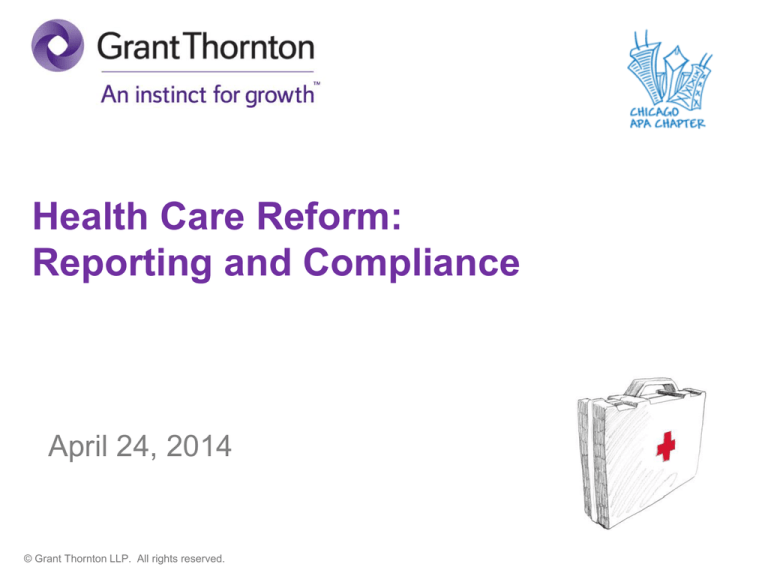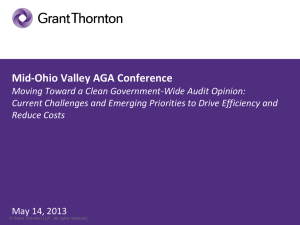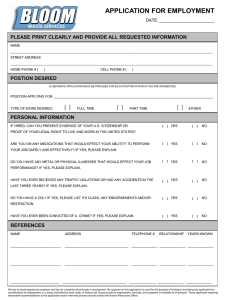
Health Care Reform:
Reporting and Compliance
April 24, 2014
© Grant Thornton LLP. All rights reserved.
Health Care Reform – Reporting and Compliance
Agenda
• Taxes (Fees) Imposed On Group Health Plans
• Individual Mandate
• Employer Mandate
• Cadillac Excise Tax
• Noncompliance Excise Tax
• Identifying and Monitoring Risks
• Preparing to be Audit Ready
© Grant Thornton LLP. All rights reserved.
2
Taxes (Fees) Imposed Upon Group Health Plans
PCORI Funding Fee
• The PCORI fee funds a new federally-chartered not-for-profit
institute designed to fund patient-centered outcomes research
• Applies to group health plans, both insured and self-funded
• Effective for 7 years beginning with plan years ending on or
after October 1, 2012 and before October 1, 2019
• Tax is due on July 31st following the end of the plan year
• Initial year fee is $1 per covered life; second year, $2; then
indexed thereafter
• Payable to the U.S. Treasury
• Fee is tax deductible
© Grant Thornton LLP. All rights reserved.
3
Taxes (Fees) Imposed Upon Group Health Plans
Transitional Reinsurance Fees
• The Reinsurance Fee subsidizes health insurance companies
with an influx of individuals from the Insurance Exchanges who
have high claims during the initial years of operations
• Applies to group health plans, both insured and self-funded
• Effective for 3 years beginning in 2014
• Tax is due on January 15th following the end of the calendar
year
• Fee is $63 per covered life for 2014; $44 per covered life for
2015; and an amount to be determined for 2016
• Payable to the Department of Health and Human Services
• Fee is tax deductible
© Grant Thornton LLP. All rights reserved.
4
Taxes (Fees) Imposed Upon Group Health Plans
Annual Fee on Health Insurance Providers
• The annual fee imposed on insurance companies generates
income to fund the Affordable Care Act
• Applies to entities which offer health insurance for any United
States health risk; does not apply to self-funded plans
• Effective January 1, 2014
• Tax is due by September 30th following the end of the calendar
year
• Fee is based on an total amount to be raised and divided
among all insurers. 2014 estimate will cost 2%-2.5%; 3-4% of
premium thereafter
• Payable to the United States Treasury
• Fee is not tax deductible
© Grant Thornton LLP. All rights reserved.
5
Health Care Reform – Reporting and Compliance
Agenda
• Taxes (Fees) Imposed On Group Health Plans
• Individual Mandate
• Employer Mandate
• Cadillac Excise Tax
• Noncompliance Excise Tax
• Identifying and Monitoring Risks
• Preparing to be Audit Ready
© Grant Thornton LLP. All rights reserved.
6
Individual Mandate
Sources of Coverage
• Beginning in 2014, individuals must acquire minimum essential
coverage or pay a penalty
• Individuals will have a number of options from which to acquire
the insurance coverage:
– Government-sponsored Insurance Exchanges
– Government-sponsored programs (e.g., Medicaid, TriCare)
– Employer-sponsored plans
– Private insurance exchanges
– Insurance companies through their agents
© Grant Thornton LLP. All rights reserved.
7
Individual Mandate
The Penalty
The individual penalty for failing to acquire minimum essential
coverage is the greater of:
Fixed Fee Per Adult
(Half for Child under age 19)
Percentage of
Household Income
2014
$95 (up to a maximum of $285)
1.0%
2015
$325 (up to a maximum of $975)
2.0%
2016
$695 (up to a maximum of $2,085)
2.5%
The fixed fee amounts will be indexed thereafter.
© Grant Thornton LLP. All rights reserved.
8
Individual Mandate
Tax credits available
Tax credit or premium reduction may be offered to individuals who
purchase coverage through an Insurance Exchange if the family
household income is between 100% and 400% of the poverty level
No Employer Coverage; or
2014 Poverty Level Guidelines
100% - 400%
Individual: $11,670 - $46,680
Household of 2: $15,730 – $62,920
Eligible Individual
State Exchange
Affordability Test
9.5% of Family Income; or
Income is between
100% - 400% of the
poverty level
Household of 4: $23,850 – $95,400
Minimum Value Test
Plan covers 60% of Plan Costs
© Grant Thornton LLP. All rights reserved.
9
Tax Credit or Plan
Cost Reduction
Health Care Reform – Reporting and Compliance
Agenda
• Taxes (Fees) Imposed On Group Health Plans
• Individual Mandate
• Employer Mandate
• Cadillac Excise Tax
• Noncompliance Excise Tax
• Identifying and Monitoring Risks
• Preparing to be Audit Ready
© Grant Thornton LLP. All rights reserved.
10
Employer Mandate
Current Transition Periods and Delays
Employer must offer health coverage that is affordable and
provides minimum value.
Employer
Size
2015 Plan Year
2016 Plan Year and Beyond
1-49 FTEs
Does not apply
Does not apply
50-99 FTEs
Does not apply
Employer must cover 95% of
FTEs and dependents to age 26
100+ FTEs
Employer must cover 70% of
Employer must cover 95% of
FTEs and dependents to age 26 FTEs and dependents to age 26
For 2015, employers will need to certify that they are not reducing
workforce to stay below 100.
© Grant Thornton LLP. All rights reserved.
11
Employer Mandate
Applicable Large Employer
• An "applicable large employer" is an employer who has 50 or
more full-time equivalent employees in the preceding calendar
year:
– For the sole purpose of determining whether an employer is
an "applicable large employer," one must add the number of
full-time employees together with the full-time equivalent
number of part-time employees
– A full-time employee is one who normally works 30 or more
hours per week
– To convert part-time employees to full-time equivalent,
• calculate the aggregate number of hours of service in a
month for employees who are part-time
• divide that number by 120
© Grant Thornton LLP. All rights reserved.
12
Employer Mandate
The penalties
• An applicable large employer with 100 or more FTE beginning in 2015
and 50-99 FTE beginning in 2016 may be subject to a penalty:
Coverage Offered to
Less than 95%* of FullTime Employees
During the Month
$166.66 Per Month
($2,000 Per Year)
Per Full-Time Employee
(Minus 30 Employees**)
Affordability
Coverage Offered to
95% or More of FullTime Employees
During the Month But
Does Not Satisfy
Affordability or
Minimum Value
Requirements
Employee Premium for Self-Only
Coverage Is 9.5% or Less
of Employee’s Income
Minimum Value
Plan Covers At Least 60%
of Plan Costs
* 70% in 2015
** Minus 80 employees for 2015
© Grant Thornton LLP. All rights reserved.
13
$250 Per Month
($3,000 Per Year)
Per Full-Time Employee
Who Purchases Insurance
Through an Exchange and
Receives a Premium Tax
Credit or Subsidy
Employer Mandate
Penalty decision tree
• An example of a detailed decision tree for 2015 penalties:
Are you an employer
with 100 or more fulltime equivalent
employees?
Do you provide
minimum essential
coverage to at least
70% of your FTE
Yes
Yes
No
Do not need to comply
with employer mandate
Yes
Pay a $166.67 per month
excise tax for each FTE
(over 80 FTEs)
No
Pay no excise tax
Did at least one employee
receive a tax credit from
an insurance exchange
established by a State?
No
Yes
Is single coverage in the
lowest price plan
affordable and does the
plan meet minimum
value of 60%?
No
© Grant Thornton LLP. All rights reserved.
Pay no excise tax
Yes
Pay a $250 per month
excise tax for each FTE
who received a tax credit
No
Pay no excise tax
Did at least one employee
receive a tax credit from
an insurance exchange
established by a State?
14
Employer Mandate
Margin of error is low
• Many employers offer coverage to all or nearly all full-time
employees. These employers should not assume they will not
be subject to the excise tax.
• Employers may easily fall below the 95% threshold and trigger
the excise tax.
Total number of fulltime employees
5% threshold
Excise tax per year
100
5
$140,000
250
12
$440,000
500
25
$940,000
1,000
50
$1,940,000
5,000
250
$9,940,000
10,000
500
$19,940,000
© Grant Thornton LLP. All rights reserved.
15
Employer Mandate
Determination of full-time employees
• IRS regulations define who is and is not a full-time employee.
• Each month, an employer must
– Identify its full-time employees - 30 or more average hours
of service per week
– Determine which full-time employees have been offered
coverage
• Full-time employees are counted in the 95% threshold
calculation after 3 months of service
More complex rules underlie these basic rules
© Grant Thornton LLP. All rights reserved.
16
Employer Mandate
Some employees are not full-time employees for the ACA
• The following are not considered to be full-time employees:
– a sole proprietor
– a partner in a partnership
– a 2% S corporation shareholder
– a leased employee (who is not a common law employee)
• The above categories of "employees" are not used in
determining whether an employer:
– is an applicable large employer or
– meets the 95% requirement to avoid the $2,000 per full-time
employee excise tax
© Grant Thornton LLP. All rights reserved.
17
Employer Mandate
Complex rules apply
• The employer must count hours for each employee
– Hourly employees: Count actual hours
– Salaried employees:
• Count actual hours, or
• Use hours-equivalency rules
• Paid time-off hours must be included
• Special rules govern the determination of full-time status of
seasonal and rehired employees
• The treatment of a new employee depends on determining
whether he or she is reasonably expected to have on average
at least 30 hours of service per week
© Grant Thornton LLP. All rights reserved.
18
Employer Mandate
Safe harbor look back periods
• Safe harbor look back periods - To make the full-time
determination more predictable, an employer can use rules that
allow an employee's status as a full-time employee in future
periods to be based on hours of service in prior periods
– On-going employees
– New employees
2014 is the measurement period to determine who meets the fulltime employee status in 2015
© Grant Thornton LLP. All rights reserved.
19
Employer Mandate
New Filters of Eligibility
Annual Enrollment
On-Going Employee
Full-Time Employee
Variable Hourly Employee
Part-Time Employee
Employees
Full-Time Employee
New Employees
Variable Hourly Employee
Monthly Enrollment
Part-time Employee
© Grant Thornton LLP. All rights reserved.
20
Employer Mandate
Safe harbor look back periods
For on-going employees…
Standard Measurement ("Look Back") Period
October 2, 2013
October 1, 2014
Administrative Period
October 2, 2014
December 31, 2014
Stability Period (Which Can Be The Plan Year)
December 31, 2015
January 1, 2015
Employees qualify during the Standard Measurement Period for
the succeeding year’s eligibility
© Grant Thornton LLP. All rights reserved.
21
Employer Mandate
Offering health benefits
• "Offering" benefits is the key – it does not matter whether an
employee accepts the offer
• If an employer fails to offer coverage to a full-time employee for
any day of the month, the employee is treated as not having
been offered coverage for the entire month
• Starting in 2015, a full-time employee can be counted as one
who has been offered coverage only if coverage is also offered
to all of the employee's dependent children
• Independent contractors and leased employees who should be
treated as full-time employees under the common law
standards must be taken into account in the 95% threshold test
© Grant Thornton LLP. All rights reserved.
22
Employer Mandate
Reporting: Minimum Essential Coverage
ACA contains a number of reporting requirements including the
new reporting requirements of IRC sections 6056 and 6055.
Provides two sets of rules:
1.
6055 Report – Collect information for the "individual
mandate." Applies to insurance carriers, self-insured plan,
etc. that provide minimum essential coverage to individuals.
2.
6056 Report- Collects information on compliance with the
"Employer Mandate." Applies to applicable large employers.
© Grant Thornton LLP. All rights reserved.
23
Employer Mandate
6055 Reporting: Minimum Essential Coverage
• IRC Section 6055 requires any entity, including group health
plans (whether insured or self-funded), that provides minimum
essential coverage to report annually
• Under final regulations, reporting is required beginning in early
2016 to report coverage provided in 2015
• An applicable large employer will report on Forms 1094-C
(transmittal) and 1095-C
• An applicable large employer will need to provide a statement
regarding the filing to each covered employee
– Form 1095-C may be used to satisfy this requirement
– Statement must be provided by January 31st of each year
© Grant Thornton LLP. All rights reserved.
24
Employer Mandate
6055 Reporting: Minimum Essential Coverage
• Information to be reported pursuant to regulations include:
– Name, address, and social security number of the employee
and his/her spouse or dependents enrolled in the plan
– The months of coverage during which the individual was
covered during the calendar year
– If the coverage is insurance, whether the coverage is a
qualified health plan (QHP) offered through a state
Insurance Exchange
– Information about the employer if an employer is filing the
return
© Grant Thornton LLP. All rights reserved.
25
Employer Mandate
6056 Reporting: Applicable Large Employers
• IRC Section 6056 requires applicable large employers to report
to the IRS whether they offer their full-time employees and their
employees' dependents the opportunity to enroll in "minimum
essential coverage"
• Under final regulations issued in March 2014, reporting is
required beginning in early 2016 to report coverage provided in
2015
• An applicable large employer will report on Forms 1094-C
(transmittal) and 1095-C (same form used for Section 6055
reporting purposes and so only one form need be used)
© Grant Thornton LLP. All rights reserved.
26
Employer Mandate
6056 Reporting: Applicable Large Employers
• An applicable large employer will need to provide a statement
to each covered employee
– Form 1095-C may be used to satisfy this requirement
– Statements must be provided by January 31st of each year
• Similar information needs to be reported for this purpose as
reported for Section 6055 purposes
• However, additional information is required concerning whether
the employer offers minimum essential coverage to its full-time
employees and whether that coverage is affordable and meets
minimum value
© Grant Thornton LLP. All rights reserved.
27
Employer Mandate
Other Reporting
• Transparency in Coverage Reporting: Group health plans
must furnish HHS with a report discussing transparency in
coverage and disclosing cost-sharing requirements
– Guidance is forthcoming
– Individuals will have right to ask for this information
• Quality of Care Reporting: Group health plans must furnish
HHS with a report addressing plan or coverage benefits and
provider reimbursements that may affect the quality of care
– Annual quality of care reports will be available to the public
through a government website
– Guidance is forthcoming
© Grant Thornton LLP. All rights reserved.
28
Health Care Reform – Reporting and Compliance
Agenda
• Taxes (Fees) Imposed On Group Health Plans
• Individual Mandate
• Employer Mandate
• Cadillac Excise Tax
• Noncompliance Excise Tax
• Identifying and Monitoring Risks
• Preparing to be Audit Ready
© Grant Thornton LLP. All rights reserved.
29
Cadillac Excise Tax
Effective 2018
• Effective in 2018, one of the most significant revenue provisions
is the 40% nondeductible excise tax on high-cost health
coverage, referred to as the "Cadillac Tax"
• The tax is determined by an employer and allocated to the
insurer, if insured, or to the party that administers the plan if selffunded. Ultimately, the plan sponsor will bear the cost of the tax
unless it is passed along to the employee
• The Cadillac Tax applies generally to coverage under a group
health plan excluding stand alone vision and dental programs
and those programs paid exclusively with after-tax dollars by the
employee
© Grant Thornton LLP. All rights reserved.
30
Cadillac Excise Tax
Thresholds
• The initial annual threshold amounts for the tax are:
– $10,200 for self-only coverage
– $27,500 for coverage other than self-only
• Threshold does include employer and employee contributions
made to a HSA or FSA
• The initial threshold amounts are subject to different adjustments:
– Health cost adjustment percentage (2018 only),
– Cost-of-living adjustment (calendar years after 2018), and
– Age and gender adjustment (applicable to 2018 and later)
© Grant Thornton LLP. All rights reserved.
31
Cadillac Excise Tax
Illustration
Sample Company's Cadillac Tax Exposure
$50,000
$45,000
Exceeds threshold by $2,691
(Tax is $1,076.35 per employee)
Exceeds threshold by $1,203
(Tax is $481.20 per employee)
$40,000
$35,000
$30,000
$25,000
Exceeds threshold by $151
(Tax is $60.46 per employee)
$20,000
$15,000
$10,000
$5,000
$Single Rate
Tax Threshold (Single)
Family Rate
Tax Threshold (Family)
2014
$7,200
$10,200
$21,000
$27,500
© Grant Thornton LLP. All rights reserved.
2015
$7,884
$10,200
$22,995
$27,500
2016
$8,633
$10,200
$25,180
$27,500
2017
$9,453
$10,200
$27,572
$27,500
32
2018
$10,351
$10,200
$30,191
$27,500
2019
$11,335
$10,710
$33,059
$28,875
2020
$12,411
$11,138
$36,200
$30,030
2021
$13,590
$11,584
$39,639
$31,231
2022
$14,881
$12,047
$43,404
$32,480
Health Care Reform – Reporting and Compliance
Agenda
• Taxes (Fees) Imposed On Group Health Plans
• Individual Mandate
• Employer Mandate
• Cadillac Excise Tax
• Noncompliance Excise Tax
• Identifying and Monitoring Risks
• Preparing to be Audit Ready
© Grant Thornton LLP. All rights reserved.
33
Noncompliance Excise Tax
• In addition, there is a general noncompliance excise tax
• The penalties for noncompliance can be significant:
– $100 per day, per employee
– Not applicable if you employ, on average throughout the year,
50 or fewer employees (looking at preceding calendar year)
• If you demonstrate reasonable cause, the penalty would be
limited to the lesser of:
– $500,000, or
– 10% of the amount you spent on health care benefits during
the prior year
© Grant Thornton LLP. All rights reserved.
34
Health Care Reform – Reporting and Compliance
Agenda
• Taxes (Fees) Imposed On Group Health Plans
• Individual Mandate
• Employer Mandate
• Cadillac Excise Tax
• Noncompliance Excise Tax
• Identifying and Monitoring Risks
• Preparing to be Audit Ready
© Grant Thornton LLP. All rights reserved.
35
Identifying and Monitoring Risks
Addressing ACA Risks
What is your position on the risks of ACA?
Visionary
Responsive
• Meeting the
Minimum
Expectations
• Strategic
Approach to
Risk
Reactionary
• Behind the
Curve
© Grant Thornton LLP. All rights reserved.
More Insight
36
Identifying and Monitoring Risks
Monitoring Risks
Evaluate
• Evaluate the workforce to determine how hours are
tracked and employees paid.
Design
• Design a program to meet the requirements of ACA,
including policies, procedures, and controls.
Implement
Monitor
Report
© Grant Thornton LLP. All rights reserved.
• Implement the program; communicate with stakeholders.
• Continually evaluate new and on-going employees to
determine "average hours" and eligibility for medical
coverage; monitor process.
• Prepare reporting process to comply with ACA and
business needs.
Identifying and Monitoring Risks
Monitoring Risks
Summary of Other Risk Areas
• Controlled group rules
• Nondiscrimination testing (TBD)
• Common law employee issue
• Break-in-service rules
• Employees who fail to pay premiums • Union employees
• Equivalency rules to determine hours • Impact of special pay practices – Per
for non-hourly employees
diem, commission only sales, fee for
service
• Alignment of measurement periods
with payroll periods
• Administrative periods
• Initial measurement periods
• Standard measurement periods
© Grant Thornton LLP. All rights reserved.
• New separate rules for
• Ongoing employees,
• New full-time employees,
• New variable hour employees,
• New seasonal employees
38
Health Care Reform – Reporting and Compliance
Agenda
• Taxes (Fees) Imposed On Group Health Plans
• Individual Mandate
• Employer Mandate
• Cadillac Excise Tax
• Noncompliance Excise Tax
• Identifying and Monitoring Risks
• Preparing to be Audit Ready
© Grant Thornton LLP. All rights reserved.
39
Audit Readiness
Limit Exposure
Limiting your liability for noncompliance
• Review internal controls around tax-related provisions
• Conduct risk and readiness assessments
• Work with internal stakeholders on ACA implementation
• Consider emerging trends and options
• Review challenges and opportunities
© Grant Thornton LLP. All rights reserved.
40
Audit Readiness
Document, Document, Document
• Document policies and procedures
• Retain individual employee records – Hire dates, re-hire dates,
hours, wages, measurement and stability periods
– Employee elections – Offered, elected, waived
– Dependent elections – Offered, elected, waived
• Retain forms – Various fees, W-2 reporting, benefit offerings,
Premium cost
• Retain results of employer mandate analysis
– Analysis of 95% full-time employee tests
– Affordability and minimum value tests
© Grant Thornton LLP. All rights reserved.
41
Health Care Reform – Reporting and Compliance
Questions
© Grant Thornton LLP. All rights reserved.
42
Health Care Reform – Reporting and Compliance
Contact Information
Andy Mechavich
Director
Grant Thornton LLP
T: 312.602.8167
E: Andy.Mechavich@us.gt.com
© Grant Thornton LLP. All rights reserved.
43
Disclaimer
This Grant Thornton LLP presentation is not a comprehensive analysis of the
subject matters covered and may include proposed guidance that is subject to
change before it is issued in final form. All relevant facts and circumstances,
including the pertinent authoritative literature, need to be considered to arrive at
conclusions that comply with matters addressed in this presentation. The views
and interpretations expressed in the presentation are those of the presenters and
the presentation is not intended to provide accounting or other advice or guidance
with respect to the matters covered.
For additional information on matters covered in this presentation, contact your
Grant Thornton LLP adviser.
© Grant Thornton LLP. All rights reserved.
44








